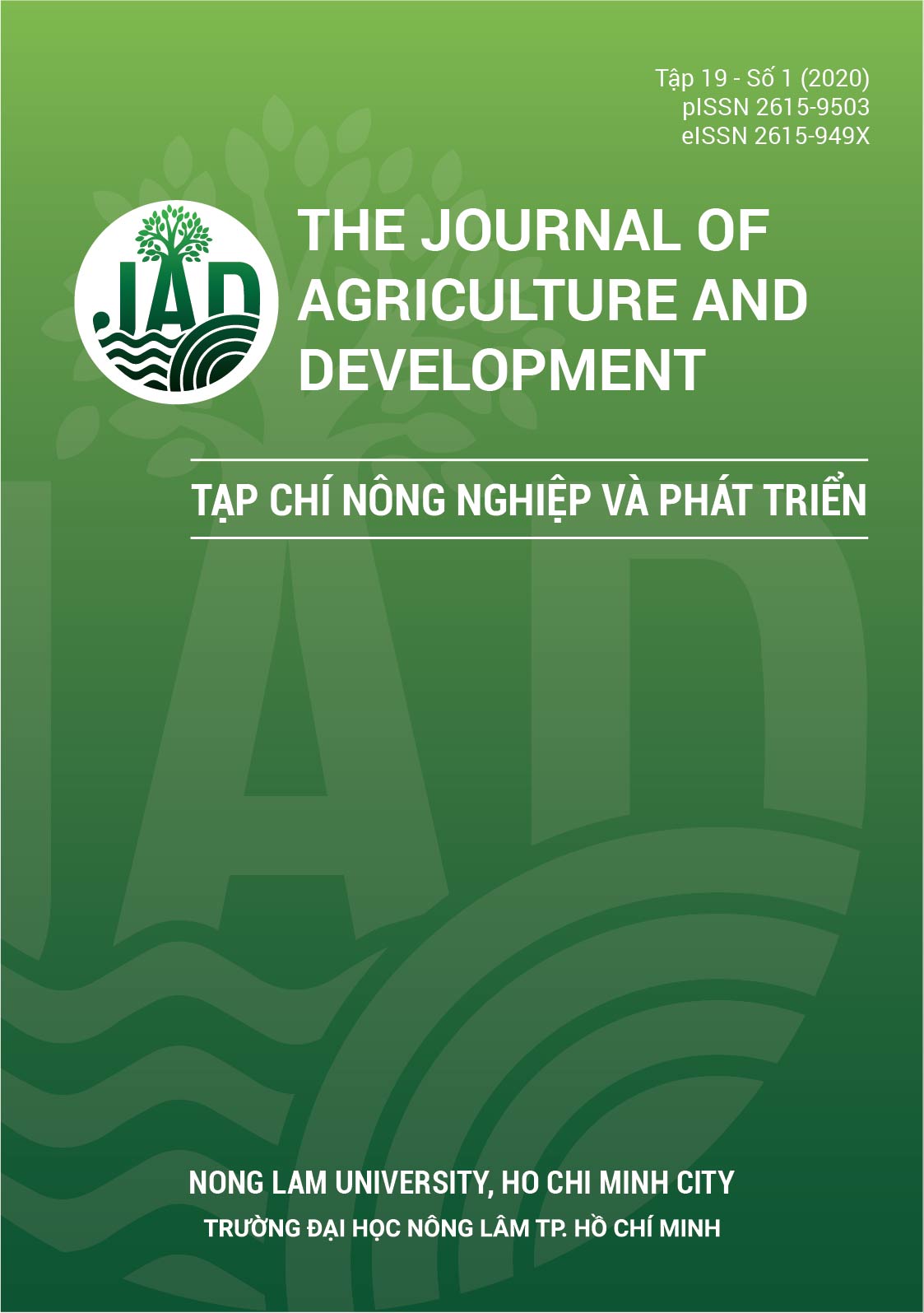Thực nghiệm ương ấu trùng tôm thẻ chân trắng (Litopenaeus vannamei Boone, 1931) bằng tảo (Thalassiosira sp.) cô đặc
Main Article Content
Tóm tắt
Mục tiêu của thí nghiệm là xác định loại tảo thích hợp cho sự tăng trưởng, tỷ lệ sống, thời gian biến thái của ấu trùng tôm thẻ chân trắng. Thí nghiệm được bố trí hoàn toàn ngẫu nhiên, gồm 5 nghiệm thức (NT): tảo khô Spirulina sp. (NT 1), tảo tươi Chaetoceros sp. (NT 2), tảo tươi Thalassiosira sp. (NT 3), tảo Thalassiosira sp. dạng lỏng (NT 4), tảo Thalassiosira sp. dạng nhão (NT 5). Bể ương có thể tích 0,5 m3, ấu trùng được bố trí ở giai đoạn Nauplius VI, mật độ 200 con/L. Chế độ chăm sóc được áp dụng theo quy trình phổ biến tại Trung tâm Quốc gia Giống Hải sản Nam Bộ. Kết quả sau 10 ngày ương, các thông số môi trường đều nằm trong khoảng cho phép sự phát triển tốt của ấu trùng. Ấu trùng tôm của NT 4 cho kết quả tốt nhất về chiều dài cơ thể, tỷ lệ sống, thời gian biến thái và khác biệt có ý nghĩa (P < 0,05) so với các nghiệm thức còn lại. Trong khi NT 5 khác biệt không có ý nghĩa (P > 0,05) so với NT 2 về chiều dài và NT 3 về thời gian biến thái. NT 1 cho kết quả kém nhất về các chỉ tiêu trên so với các nghiệm thức khác. Nhìn chung, việc sử dụng tảo Thalassiosira sp. dạng lỏng để ương ấu trùng tôm thẻ chân trắng cho kết quả tốt và nên được áp dụng phổ biến.
Article Details
Tài liệu tham khảo
Ashashalini, A., Syed, A., Anuradha, V. M., Yogannanth, N., Suganya, V., & Bhuvana, P. (2018). Cultivation, Quantification and Pharmacognostic Study of methanolic extract of Thalassiosira sp.. Journal of Pharmacy 8(10), 36-43.
FAO (Food and Agriculture Organization of The United Nations. (2003). Health management and biosecurity maintenance in white shrimp (Penaeus vannamei) hatcheries in Latin America. Retrieved August 25, 2019, from http://www.fao.org/3/y5040e/y5040e00.htm#Contents.
FISTENET (Directorate of Fisheries). (2019). The conference discussed solutions to manage marine shrimp breeds. Retrieved August 28, 2019, from https://www.fistenet.gov.vn/News/hoi-nghi-ban-cac-giai-phap-quan-ly-giong-tom-nuoc-lo.
Iba, W., Rice, M. A., & Wikrors G. H. (2014). Microalgae in Eastern Pacific white shrimp, Litopenaeus vannamei (Boone 1931) Hatcheries: A Review on roles and culture environments. Asian Fisheries Society 27(2014), 212-233.
ISC (Invasive Species Compendium). (2019). Litopenaeus vannamei (white leg shrimp). Retrieved August 25, 2019, from https://www.cabi.org/isc/datasheetC880.
Kiatmetha, P., Siangdang, W., Bunnag, B., Senapin, S., & Withyachumnarnkul, B. (2010). Enhancement of survival and metamorphosis rates of Penaeus monodon larvae by feeding with the diatom Thalassiosira sp.. Aquaculture International 19(4), 599-609. https://doi.org/10.1007/s10499-010-9375-y
Ly, K. V., Vo, S. N., Pho, N. V., & Tran, H. N. (2015). The current status of technique and finance in the seed production of whiteleg shrimp in the Mekong Delta. Can Tho University Journal of Science 39, 108-117.
Ngo, T. A., & Trinh, L. V. (2009). Research on broodstock culture and artificial reproduction of white leg shrimp (Penaeus vannamei Boone, 1931) in Khanh Hoa. Journal of Fisheries Science and Technology, 40-48.
Pablo, P., Mario, N., Luis, R., Cesar, C. O., & Domenico, V. (2005). Survival, growth and feeding efficiency of Litopenaeus vannamei protozoa larvae fed different rations of the diatom Chaetoceros muelleri. Aquaculture 249, 431-437.
Palacios, E., Racotta, I. S., Heras, H., Marty, Y., Moal, J., & Samain, J. F. (2001). Relation between lipid and fatty acid composition of eggs and larval survival in white pacific shrimp (Penaeus vannamei, Boone, 1931). Aquaculture 9, 531-543. https://doi.org/10.1023/A:1020589924810
Pratoomyot, J., Srivilas, P., & Noiraksar, T. (2005). Fatty acids composition of 10 microalgal species. Songklanakarin Journal of Science and Technology 27(6), 1179-1187.
Sangha, R. S., Cruz, A. C. P., Chavez-Sanchez, M. C., & Jones, D. A. (2000). Survival and growth of Litopenaeus vannamei (Boone) larvae fed a single dose of live algae and artificial diets with supplements. Aquaculture Research 31, 683-689. https://doi.org/10.1046/j.1365-2109.2000.318487.x








